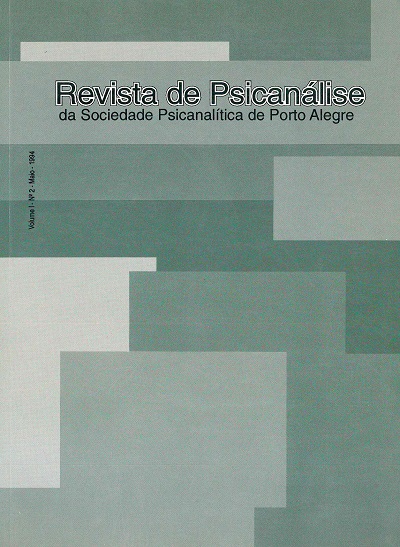A interpretação efetiva: a sua formulação e a sua recepção
Abstract
Utilizando material clínico de uma paciente em análise, a autora discute dificuldades na formulação e apresentação de interpretações para pacientes severamente perturbados. Trata se de pacientes em que as relações de objeto estão de tal forma afetadas pela incapacidade de escutarem e absorverem as interpretações que essa incapacidade torna se o problema central de suas análises. No presente trabalho usarei material clínico de uma paciente para discutir algumas dificuldades na formulação e apresentação de interpretações a pacientes nos quais a natureza da sua doença afeta seriamente o modo pelo qual escutam e ouvem interpretações. Estou pensando, particularmente, a respeito de pacientes severamente perturbados, nos quais a dificuldade fundamental de reconhecer a separação em relação ao objeto, e os mecanismos usados para manter afastada a consciência de ser separado, alteram profundamente a experiência, para o analista, de interpretar e, para o paciente, de receber a interpretação. As relações de objeto destes pacientes são seriamente afetadas pela incapacidade de escutarem e absorverem e, naturalmente, esta incapacidade torna se o problema central nas suas análises.
Downloads
References
BION, W. R. (1967). Second Thoughts. London: Heinemann.
JOSEPH, B. (1982). Addiction to near death. IJPA. 63: 449 56.
(1987). Projective identification, some clinical aspects, in J. Sandler (ed). Projection identification, projective identification. New York: International Universities Press, 1987. Também in E. Spillius (ed) Melanie KIeinToday. London: Routledge, 1988.
MELTZER. D. (1966). The relation of anal masturbation to projective identification, IJPA. 47: 335 42.
(1968). Terror, persecution and dread, IJPA. 49: 396 40.
REIS ENBERG MALCOLM, R., (1981). Expiation as a defense, Int. Jnl. Psycho Analytic Psycho therapy, 8: 549 70.
ROSENFELD, H. A. (1964). On the psychopathology of narcissism: a clinical approach, IJPA, 45: 332 7.
(1971). A clinical approach to the psychoanalytical theory of the life and death instincts an investigation into the aggressive aspects of narcissism, IJPA. 52: 169 78.
SEGAL, H. (1981). The Work of Hanna Segal. New York: Jason Aronson.
SOHN, I. (1985). Narcissistic organization, projective identification and the formation of the identificate, IJPA, 66: 201 13.
STEINER, J. (1982) Perverse relationships between parts of the self: aclinical illustration, IJPA, 63: 241 51.
(1987). The interplay between pathological organizations and the paranoid schizoid and depressive positions, OPA, 68: 69 80.
Downloads
Published
How to Cite
Issue
Section
License

This work is licensed under a Creative Commons Attribution-NonCommercial-NoDerivatives 4.0 International License.
Atribuo os direitos autorais que pertencem a mim, sobre o presente trabalho, à SPPA, que poderá utilizá-lo e publicá-lo pelos meios que julgar apropriados, inclusive na Internet ou em qualquer outro processamento de computador.
I attribute the copyrights that belong to me, on this work, to SPPA, which may use and publish it by the means it deems appropriate, including on the Internet or in any other computer processing.
Atribuyo los derechos de autor que me pertenecen, sobre este trabajo, a SPPA, que podrá utilizarlo y publicarlo por los medios que considere oportunos, incluso en Internet o en cualquier otro tratamiento informático.










